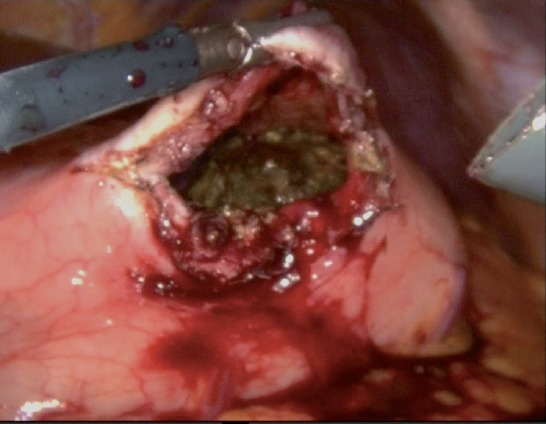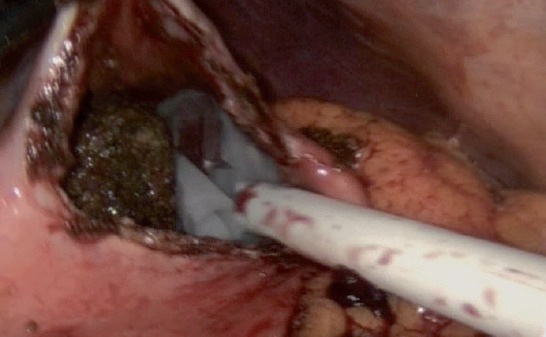Abstract
Bezoar is an intraluminal mass formed by the accumulation of undigested material anywhere in the gastrointestinal system. Most of small bezoars are removed by gastrointestinal endoscopy, while the best approach for the larger ones is surgical removal. Currently, laparoscopic technique is successfully used in the treatment of bezoars, which are used to be managed by open surgery. In the laparoscopic treatment of bezoars, contamination of peritoneal cavity is a major problem. We describe a modified laparoscopic technique in which an endobag is placed in the stomach instead of the peritoneal cavity in order to avoid spillage of the bezoar during laparoscopic removal.
Bezoar is a mass composed of undigested food, fiber, and hair, trapped anywhere along the gastrointestinal (GI) tract. It is found mostly in the stomach, due to the stumbling block of the pylorus.1,2 Most small bezoars are removed by GI endoscopy, while the best approach for the larger ones is surgical removal.1,3 During laparoscopic removal of large gastric bezoars, an endobag, placed within the peritoneal cavity, is used in the fragmantation and extraction of the bezoar. Yet, this may cause spillage and peritoneal contamination. This presentation describes a modified laparoscopic technique in which an endobag is placed in the stomach instead of the peritoneal cavity in order to avoid spillage of the bezoar during laparoscopic removal.
Case Report
A 60-year-old female patient with symptoms of nausea, vomiting, early satiety, and weight loss for the last 6 months was admitted to our clinic. Stats revealed hypoalbuminemia and anemia. Upper GI endoscopy revealed a 10 cm bezoar in the gastric fundus, which could not be extracted by gastroscopy and a 3 cm antral ulcer due to bezoar compression. The result of histopathological analysis of gastric ulcer was benign. We decided to remove the bezoar via laparoscopic approach. A 10 mm trocar was placed infraumbilically, and a mass image was seen in the stomach during exploration. A secondary 10 mm trocar was placed in the left lower quadrant and 2 additional ancillary 5 mm ports, on the right side, paracolically. A 5-6 cm gastrotomy was made on the anterior surface of the gastric antrum using the monopolar energy in the pure cutting mode (Figure 1). An endobag was introduced into the abdominal cavity through the 10 mm trocar. With the guidance of optic imaging it was inserted into the stomach transperitoneally, without encountering any difficulty via the gastrotomy (Figure 2) and opened easily inside the stomach. The bezoar was mobile inside the stomach, grasped atraumatically and placed in the endobag, which was opened in the gastric lumen. Fragmentation was carried out within the endobag and there was no need to enlarge gastrotomy incision. The specimen was taken out without intra-abdominal spillage. Gastrotomy was then closed with one-layer, separate 2-0 vicryl sutures, intracorporeally. The abdomen was drained for 24 hours postoperatively. The surgery was completed within 120 minutes, and she was discharged on the 6th postoperative day without any complication.
Figure 1.

Gastrotomy was made on the anterior surface of the gastric antrum with a monopolar hook.
Figure 2.

Endobag opened in the stomach via the laparoscopically incized gastrotomy.
Discussion
Bezoars are divided into 5 groups according to their content; phytobezoar, tricobezoar, lactobezoar, medication bezoar, and bolus food. The incidence of bezoar is 0.4%.4 Decreased acid secretion, gastroparesis, and gastric outlet obstruction facilitate bezoar formation. Also, inadequate chewing of food, which is difficult to digest, may influence bezoar formation.5 Most common predisposing factors are diabetic gastroparesis and gastric dismotility after surgery.5 Mostly vagotomy, pyloroplasty, and in a lesser extent antrectomy may lead to bezoar formation. It can also occur without any predisposing factor by eating hair or too much palm.3 Some series reported prior abdominal surgeries and co-morbidities as the leading cause of bezoar formation, and some series proposed ineffective chewing of food in patients with dental problems as the key point in bezoar formation.6 Our patient did not have any prior abdominal surgery, but she had bad oral hygiene and dental problems. Stomach and small bowel ulcers and perforations, chronic GI bleeding, intussusceptions, obstruction, pancreatitis, cholangitis, anemia, and malnutrition are among their complications and can cause mortality up to 30%.6,7 The case we present had early satiety, vomiting, weight loss, anemia, hypoalbuminemia, and gastric ulcer. The diagnosis is established via GI endoscopy, GI contrast study, or computerized tomography.8 Enzymatic and gastric motility increasing agents are among the medical treatment options. As a medical treatment modality, some authors used Coca-Cola for small gastric phytobezoar and reported that up to 23-50% of bezoar can be dissolved.1 Gastrointestinal endoscopy is a golden standard in the diagnosis and treatment of small gastric bezoar. For this purpose, water jets, forceps, lithotripters, and baskets are used for gastroscopic fragmentation. This treatment depends on the composition and size of the bezoar and the experience of the clinician. In case of failure with medical and GI endoscopic treatment options, surgery is conceivable.3,5 Laparoscopy providing smaller incision, less postoperative pain, and better cosmetic results, is an alternative method to conventional open surgery. However, there is a risk of spillage and peritoneal contamination due to the use of endobag placed in the peritoneal cavity. In the technique we used, since the endobag is inserted through the gastrotomy and opened in gastric lumen, and the bezoar is put into the endobag inside the stomach, spillage and contamination of peritoneal cavity is expected to be negligible. Limitations of this technique for large gastric bezoars are, the need for experienced laparoscopic surgeons, location, and adhesions of the bezoar inside the stomach. The size of the endobag used, sets the limits for the size of bezoars, which can be removed by this technique. Hybrid techniques in which laparoscopy and laparotomy are used concomitantly with an aim to prevent peritoneal contamination have been reported in the literature. The modification suggested by Tudor and Clark9 is a technique in which stomach is sutured to the anterior abdominal wall and a device is used to minimize peritoneal contamination. Son et al,10 described a method where they used one port to make the gastrostomy and closed it extra corporeally by using staplers. They reported less contamination. There are some differences between authors in applying the technique, but there is no evidence supporting one technique to be better than the other. Gastrostomy can be closed either intra or extra corporeally and both with stapler or suture.2,3 These combined techniques are excellent for giant bezoars, which are very difficult to remove by the traditional laparoscopic technique. On the other hand, these techniques have more complications and the duration of the operation is longer than the technique we proposed (3.5 versus 2 hours). Therefore, we think that these hybrid techniques should be used only for the removal of giant bezoars. For the smaller bezoars, which are not suitable for GI endoscopic removal, our technique would be a better option.
In conclusion, we believe that laparoscopy is a safe and reliable procedure in bezoar treatment without the need of an additional abdominal incision, except for the giant bezoars. In the technique we used, contamination is expected to be less, since the bezoar is put into the endobag placed in the stomach instead of the peritoneal cavity. The main disadvantage of this technique is the inapplicability for giant bezoars. Furthermore, it is difficult to use it in the removal of intestinal bezoars. Prospective studies are necessary to determine optimal treatment strategies for different kinds of bezoars in different locations.
Footnotes
Case Reports.
Case reports will only be considered for unusual topics that add something new to the literature. All Case Reports should include at least one figure. Written informed consent for publication must accompany any photograph in which the subject can be identified. Figures should be submitted with a 300 dpi resolution when submitting electronically. The abstract should be unstructured, and the introductory section should always include the objective and reason why the author is presenting this particular case. References should be up to date, preferably not exceeding 15.
References
- 1.Ladas SD, Kamberoglou D, Karamanolis G, Vlachogiannakos J, Zouboulis-Vafiadis I. Systematic review: Coca-Cola can effectively dissolve gastric phytobezoars as a first-line treatment. Aliment Pharmacol Ther. 2013;37:169–173. doi: 10.1111/apt.12141. [DOI] [PubMed] [Google Scholar]
- 2.Lee BJ, Park JJ, Chun HJ, Kim JH, Yeon JE, Jeen YT, et al. How good is cola for dissolution of gastric phytobezoars? World J Gastroenterol. 2009;15:2265–2269. doi: 10.3748/wjg.15.2265. [DOI] [PMC free article] [PubMed] [Google Scholar]
- 3.Song KY, Choi BJ, Kim SN, Park CH. Laparoscopic removal of gastric bezoar. Surg Laparosc Endosc Percutan Tech. 2007;17:42–44. doi: 10.1097/01.sle.0000213765.86170.77. [DOI] [PubMed] [Google Scholar]
- 4.Sharma D, Srivastava M, Babu R, Anand R, Rohtagi A, Thomas S. Laparoscopic treatment of gastric bezoar. JSLS. 2010;14:263–267. doi: 10.4293/108680810X12785289144566. [DOI] [PMC free article] [PubMed] [Google Scholar]
- 5.Gorter RR, Kneepkens CM, Mattens EC, Aronson DC, Heij HA. Management of trichobezoar: case report and literature review. Pediatr Surg Int. 2010;26:457–463. doi: 10.1007/s00383-010-2570-0. [DOI] [PMC free article] [PubMed] [Google Scholar]
- 6.Oh SH, Namgung H, Park MH, Park DG. Bezoar-induced Small Bowel Obstruction. J Korean Soc Coloproctol. 2012;28:89–93. doi: 10.3393/jksc.2012.28.2.89. [DOI] [PMC free article] [PubMed] [Google Scholar]
- 7.Çolakoğlu T, Ezer A, Belli S, Aytaç Ö, Parlakgümüs A, Yıldırım S. Ileus due to bezoars. UlusCerrahi Derg. 2010;26:157–160. [Google Scholar]
- 8.Javed A, Agarwal A K. A modified minimally invasive technique for the surgical management of large trichobezoars. J Minim Access Surg. 2013;9:42–44. doi: 10.4103/0972-9941.107142. [DOI] [PMC free article] [PubMed] [Google Scholar]
- 9.Tudor ECG, Clark MC. Laparoscopic- assisted removal of gastric trichobezoar;a novel technique to reduce operative complications and time. Journal of pediatric Surgery. 2013;48:E13–E15. doi: 10.1016/j.jpedsurg.2012.12.028. [DOI] [PubMed] [Google Scholar]
- 10.Son T, Inaba K, Woo Y, Pak KH, Hyung WJ, Noh SH. New surgical approach for gastric bezoar: “hybrid access surgery” combined intragastric and single port surgery. J Gastric Cancer. 2011;11:230–233. doi: 10.5230/jgc.2011.11.4.230. [DOI] [PMC free article] [PubMed] [Google Scholar]


